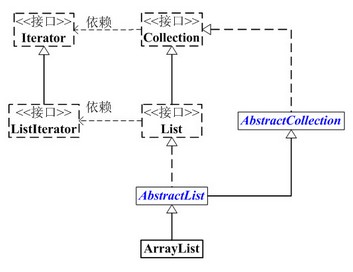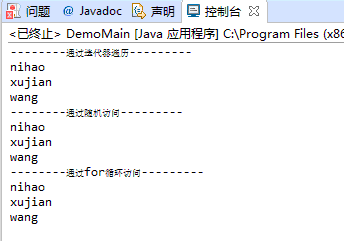一、ArrayList简介
ArrayList是可以动态增长和缩减的索引序列,它是基于数组实现的List类。
该类封装了一个动态再分配的Object[]数组,每一个类对象都有一个capacity属性,表示它们所封装的Object[]数组的长度,当向ArrayList中添加元素时,该属性值会自动增加。如果想ArrayList中添加大量元素,可使用ensureCapacity方法一次性增加capacity,可以减少增加重分配的次数提高性能。
ArrayList的用法和Vector向类似,但是Vector是一个较老的集合,具有很多缺点,不建议使用。另外,ArrayList和Vector的区别是:ArrayList是线程不安全的,当多条线程访问同一个ArrayList集合时,程序需要手动保证该集合的同步性,而Vector则是线程安全的。
ArrayList与Collection关系如下图:

二、ArrayList源码分析
下面就ArrayList的源代码进行简单的分析:
public class ArrayList<E> extends AbstractList<E> implements List<E>, RandomAccess, Cloneable, java.io.Serializable { private static final long serialVersionUID = 8683452581122892189L; //默认的初始容量为10 private static final int DEFAULT_CAPACITY = 10; private static final Object[] EMPTY_ELEMENTDATA = {}; private static final Object[] DEFAULTCAPACITY_EMPTY_ELEMENTDATA = {}; transient Object[] elementData; // ArrayList中实际数据的数量 private int size; public ArrayList(int initialCapacity) //带初始容量大小的构造函数 { if (initialCapacity > 0) //初始容量大于0,实例化数组 { this.elementData = new Object[initialCapacity]; } else if (initialCapacity == 0) //初始化等于0,将空数组赋给elementData { this.elementData = EMPTY_ELEMENTDATA; } else //初始容量小于,抛异常 { throw new IllegalArgumentException("Illegal Capacity: "+ initialCapacity); } } public ArrayList() //无参构造函数,默认容量为10 { this.elementData = DEFAULTCAPACITY_EMPTY_ELEMENTDATA; } public ArrayList(Collection<? extends E> c) //创建一个包含collection的ArrayList { elementData = c.toArray(); //返回包含c所有元素的数组 if ((size = elementData.length) != 0) { if (elementData.getClass() != Object[].class) elementData = Arrays.copyOf(elementData, size, Object[].class);//复制指定数组,使elementData具有指定长度 } else { //c中没有元素 this.elementData = EMPTY_ELEMENTDATA; } } //将当前容量值设为当前实际元素大小 public void trimToSize() { modCount++; if (size < elementData.length) { elementData = (size == 0)? EMPTY_ELEMENTDATA:Arrays.copyOf(elementData, size); } } //将集合的capacit增加minCapacity public void ensureCapacity(int minCapacity) { int minExpand = (elementData != DEFAULTCAPACITY_EMPTY_ELEMENTDATA)?0:DEFAULT_CAPACITY; if (minCapacity > minExpand) { ensureExplicitCapacity(minCapacity); } } private void ensureCapacityInternal(int minCapacity) { if (elementData == DEFAULTCAPACITY_EMPTY_ELEMENTDATA) { minCapacity = Math.max(DEFAULT_CAPACITY, minCapacity); } ensureExplicitCapacity(minCapacity); } private void ensureExplicitCapacity(int minCapacity) { modCount++; if (minCapacity - elementData.length > 0) grow(minCapacity); } private static final int MAX_ARRAY_SIZE = Integer.MAX_VALUE - 8; private void grow(int minCapacity) { int oldCapacity = elementData.length;
//注意此处扩充capacity的方式是将其向右一位再加上原来的数,实际上是扩充了1.5倍 int newCapacity = oldCapacity + (oldCapacity >> 1); if (newCapacity - minCapacity < 0) newCapacity = minCapacity; if (newCapacity - MAX_ARRAY_SIZE > 0) newCapacity = hugeCapacity(minCapacity); elementData = Arrays.copyOf(elementData, newCapacity); } private static int hugeCapacity(int minCapacity) { if (minCapacity < 0) // overflow throw new OutOfMemoryError(); return (minCapacity > MAX_ARRAY_SIZE) ? Integer.MAX_VALUE : MAX_ARRAY_SIZE; } //返回ArrayList的大小 public int size() { return size; } //判断ArrayList是否为空 public boolean isEmpty() { return size == 0; } //判断ArrayList中是否包含Object(o) public boolean contains(Object o) { return indexOf(o) >= 0; } //正向查找,返回ArrayList中元素Object(o)的索引位置 public int indexOf(Object o) { if (o == null) { for (int i = 0; i < size; i++) if (elementData[i]==null) return i; } else { for (int i = 0; i < size; i++) if (o.equals(elementData[i])) return i; } return -1; } //逆向查找,返回返回ArrayList中元素Object(o)的索引位置 public int lastIndexOf(Object o) { if (o == null) { for (int i = size-1; i >= 0; i--) if (elementData[i]==null) return i; } else { for (int i = size-1; i >= 0; i--) if (o.equals(elementData[i])) return i; } return -1; } //返回此 ArrayList实例的浅拷贝。 public Object clone() { try { ArrayList<?> v = (ArrayList<?>) super.clone(); v.elementData = Arrays.copyOf(elementData, size); v.modCount = 0; return v; } catch (CloneNotSupportedException e) { // this shouldn't happen, since we are Cloneable throw new InternalError(e); } } //返回一个包含ArrayList中所有元素的数组 public Object[] toArray() { return Arrays.copyOf(elementData, size); } @SuppressWarnings("unchecked") public <T> T[] toArray(T[] a) { if (a.length < size) return (T[]) Arrays.copyOf(elementData, size, a.getClass()); System.arraycopy(elementData, 0, a, 0, size); if (a.length > size) a[size] = null; return a; } @SuppressWarnings("unchecked") E elementData(int index) { return (E) elementData[index]; } //返回至指定索引的值 public E get(int index) { rangeCheck(index); //检查给定的索引值是否越界 return elementData(index); } //将指定索引上的值替换为新值,并返回旧值 public E set(int index, E element) { rangeCheck(index); E oldValue = elementData(index); elementData[index] = element; return oldValue; } //将指定的元素添加到此列表的尾部 public boolean add(E e) { ensureCapacityInternal(size + 1); elementData[size++] = e; return true; } // 将element添加到ArrayList的指定位置 public void add(int index, E element) { rangeCheckForAdd(index); ensureCapacityInternal(size + 1); //从指定源数组中复制一个数组,复制从指定的位置开始,到目标数组的指定位置结束。 //arraycopy(被复制的数组, 从第几个元素开始复制, 要复制到的数组, 从第几个元素开始粘贴, 一共需要复制的元素个数) //即在数组elementData从index位置开始,复制到index+1位置,共复制size-index个元素 System.arraycopy(elementData, index, elementData, index + 1,size - index); elementData[index] = element; size++; } //删除ArrayList指定位置的元素 public E remove(int index) { rangeCheck(index); modCount++; E oldValue = elementData(index); int numMoved = size - index - 1; if (numMoved > 0) System.arraycopy(elementData, index+1, elementData, index,numMoved); elementData[--size] = null; //将原数组最后一个位置置为null return oldValue; } //移除ArrayList中首次出现的指定元素(如果存在)。 public boolean remove(Object o) { if (o == null) { for (int index = 0; index < size; index++) if (elementData[index] == null) { fastRemove(index); return true; } } else { for (int index = 0; index < size; index++) if (o.equals(elementData[index])) { fastRemove(index); return true; } } return false; } //快速删除指定位置的元素 private void fastRemove(int index) { modCount++; int numMoved = size - index - 1; if (numMoved > 0) System.arraycopy(elementData, index+1, elementData, index, numMoved); elementData[--size] = null; } //清空ArrayList,将全部的元素设为null public void clear() { modCount++; for (int i = 0; i < size; i++) elementData[i] = null; size = 0; } //按照c的迭代器所返回的元素顺序,将c中的所有元素添加到此列表的尾部 public boolean addAll(Collection<? extends E> c) { Object[] a = c.toArray(); int numNew = a.length; ensureCapacityInternal(size + numNew); // Increments modCount System.arraycopy(a, 0, elementData, size, numNew); size += numNew; return numNew != 0; } //从指定位置index开始,将指定c中的所有元素插入到此列表中 public boolean addAll(int index, Collection<? extends E> c) { rangeCheckForAdd(index); Object[] a = c.toArray(); int numNew = a.length; ensureCapacityInternal(size + numNew); // Increments modCount int numMoved = size - index; if (numMoved > 0) //先将ArrayList中从index开始的numMoved个元素移动到起始位置为index+numNew的后面去 System.arraycopy(elementData, index, elementData, index + numNew, numMoved); //再将c中的numNew个元素复制到起始位置为index的存储空间中去 System.arraycopy(a, 0, elementData, index, numNew); size += numNew; return numNew != 0; } //删除fromIndex到toIndex之间的全部元素 protected void removeRange(int fromIndex, int toIndex) { modCount++; //numMoved为删除索引后面的元素个数 int numMoved = size - toIndex; //将删除索引后面的元素复制到以fromIndex为起始位置的存储空间中去 System.arraycopy(elementData, toIndex, elementData, fromIndex,numMoved); int newSize = size - (toIndex-fromIndex); //将ArrayList后面(toIndex-fromIndex)个元素置为null for (int i = newSize; i < size; i++) { elementData[i] = null; } size = newSize; } //检查索引是否越界 private void rangeCheck(int index) { if (index >= size) throw new IndexOutOfBoundsException(outOfBoundsMsg(index)); } private void rangeCheckForAdd(int index) { if (index > size || index < 0) throw new IndexOutOfBoundsException(outOfBoundsMsg(index)); } private String outOfBoundsMsg(int index) { return "Index: "+index+", Size: "+size; } //删除ArrayList中包含在c中的元素 public boolean removeAll(Collection<?> c) { Objects.requireNonNull(c); return batchRemove(c, false); } //删除ArrayList中除包含在c中的元素,和removeAll相反 public boolean retainAll(Collection<?> c) { Objects.requireNonNull(c); //检查指定对象是否为空 return batchRemove(c, true); } private boolean batchRemove(Collection<?> c, boolean complement) { final Object[] elementData = this.elementData; int r = 0, w = 0; boolean modified = false; try { for (; r < size; r++) if (c.contains(elementData[r]) == complement) //判断c中是否有elementData[r]元素 elementData[w++] = elementData[r]; } finally { if (r != size) { System.arraycopy(elementData, r, elementData, w, size - r); w += size - r; } if (w != size) { // clear to let GC do its work for (int i = w; i < size; i++) elementData[i] = null; modCount += size - w; size = w; modified = true; } } return modified; } //将ArrayList的“容量,所有的元素值”都写入到输出流中 private void writeObject(java.io.ObjectOutputStream s) throws java.io.IOException { int expectedModCount = modCount; s.defaultWriteObject(); //写入数组大小 s.writeInt(size); //写入所有数组的元素 for (int i=0; i<size; i++) { s.writeObject(elementData[i]); } if (modCount != expectedModCount) { throw new ConcurrentModificationException(); } } //先将ArrayList的“大小”读出,然后将“所有的元素值”读出 private void readObject(java.io.ObjectInputStream s) throws java.io.IOException, ClassNotFoundException { elementData = EMPTY_ELEMENTDATA; s.defaultReadObject(); s.readInt(); // ignored if (size > 0) { // be like clone(), allocate array based upon size not capacity ensureCapacityInternal(size); Object[] a = elementData; // Read in all elements in the proper order. for (int i=0; i<size; i++) { a[i] = s.readObject(); } } }
三、ArrayList遍历方式
ArrayList支持3种遍历方式
1、通过迭代器遍历:
Iterator iter = list.iterator(); while (iter.hasNext()) { System.out.println(iter.next()); }
2、随机访问,通过索引值去遍历,由于ArrayList实现了RandomAccess接口
int size = list.size(); for (int i=0; i<size; i++) { System.out.println(list.get(i)); }
3、for循环遍历:
for(String str:list) { System.out.println(str); }
完整的代码示例如下:
public class DemoMain { public static void main(String[] args) { List<String> list=new ArrayList<String>(); list.add("nihao"); list.add("xujian"); list.add("wang"); System.out.println("--------通过迭代器遍历---------"); Iterator iter = list.iterator(); while (iter.hasNext()) { System.out.println(iter.next()); } System.out.println("--------通过随机访问---------"); int size = list.size(); for (int i=0; i<size; i++) { System.out.println(list.get(i)); } System.out.println("--------通过for循环访问---------"); for(String str:list) { System.out.println(str); } } }
运行结果如图示:
